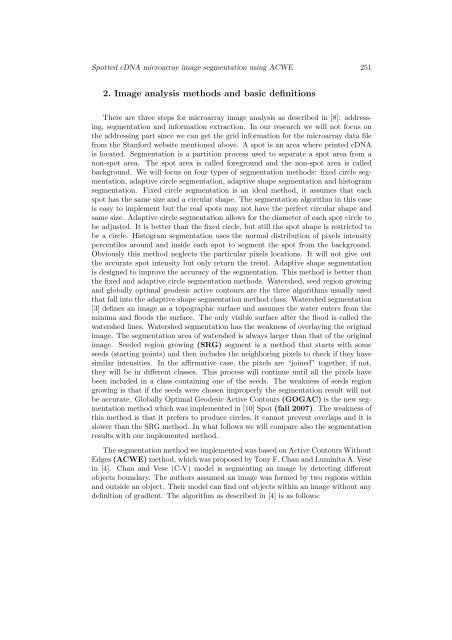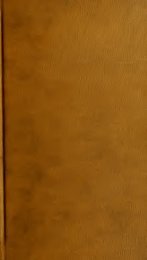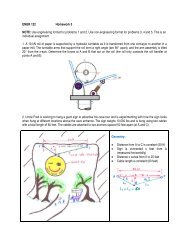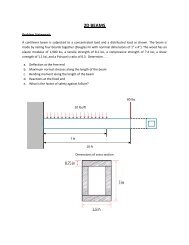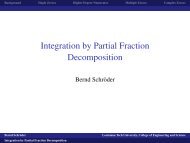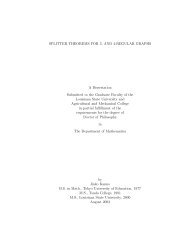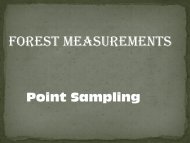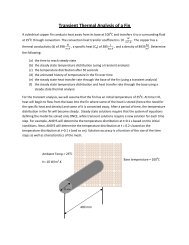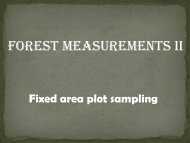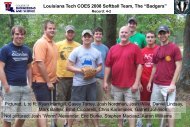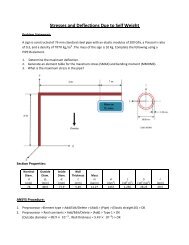Spotted cDNA microarray image segmentation ... - IMT Bucharest
Spotted cDNA microarray image segmentation ... - IMT Bucharest
Spotted cDNA microarray image segmentation ... - IMT Bucharest
- No tags were found...
You also want an ePaper? Increase the reach of your titles
YUMPU automatically turns print PDFs into web optimized ePapers that Google loves.
<strong>Spotted</strong> <strong>cDNA</strong> <strong>microarray</strong> <strong>image</strong> <strong>segmentation</strong> using ACWE 2512. Image analysis methods and basic definitionsThere are three steps for <strong>microarray</strong> <strong>image</strong> analysis as described in [8]: addressing,<strong>segmentation</strong> and information extraction. In our research we will not focus onthe addressing part since we can get the grid information for the <strong>microarray</strong> data filefrom the Stanford website mentioned above. A spot is an area where printed <strong>cDNA</strong>is located. Segmentation is a partition process used to separate a spot area from anon-spot area. The spot area is called foreground and the non-spot area is calledbackground. We will focus on four types of <strong>segmentation</strong> methods: fixed circle <strong>segmentation</strong>,adaptive circle <strong>segmentation</strong>, adaptive shape <strong>segmentation</strong> and histogram<strong>segmentation</strong>. Fixed circle <strong>segmentation</strong> is an ideal method, it assumes that eachspot has the same size and a circular shape. The <strong>segmentation</strong> algorithm in this caseis easy to implement but the real spots may not have the perfect circular shape andsame size. Adaptive circle <strong>segmentation</strong> allows for the diameter of each spot circle tobe adjusted. It is better than the fixed circle, but still the spot shape is restricted tobe a circle. Histogram <strong>segmentation</strong> uses the normal distribution of pixels intensitypercentiles around and inside each spot to segment the spot from the background.Obviously this method neglects the particular pixels locations. It will not give outthe accurate spot intensity but only return the trend. Adaptive shape <strong>segmentation</strong>is designed to improve the accuracy of the <strong>segmentation</strong>. This method is better thanthe fixed and adaptive circle <strong>segmentation</strong> methods. Watershed, seed region growingand globally optimal geodesic active contours are the three algorithms usually usedthat fall into the adaptive shape <strong>segmentation</strong> method class. Watershed <strong>segmentation</strong>[3] defines an <strong>image</strong> as a topographic surface and assumes the water enters from theminima and floods the surface. The only visible surface after the flood is called thewatershed lines. Watershed <strong>segmentation</strong> has the weakness of overlaying the original<strong>image</strong>. The <strong>segmentation</strong> area of watershed is always larger than that of the original<strong>image</strong>. Seeded region growing (SRG) segment is a method that starts with someseeds (starting points) and then includes the neighboring pixels to check if they havesimilar intensities. In the affirmative case, the pixels are “joined” together, if not,they will be in different classes. This process will continue until all the pixels havebeen included in a class containing one of the seeds. The weakness of seeds regiongrowing is that if the seeds were chosen improperly the <strong>segmentation</strong> result will notbe accurate. Globally Optimal Geodesic Active Contours (GOGAC) is the new <strong>segmentation</strong>method which was implemented in [10] Spot (fall 2007). The weakness ofthis method is that it prefers to produce circles, it cannot prevent overlaps and it isslower than the SRG method. In what follows we will compare also the <strong>segmentation</strong>results with our implemented method.The <strong>segmentation</strong> method we implemented was based on Active Contours WithoutEdges (ACWE) method, which was proposed by Tony F. Chan and Luminita A. Vesein [4]. Chan and Vese (C-V) model is segmenting an <strong>image</strong> by detecting differentobjects boundary. The authors assumed an <strong>image</strong> was formed by two regions withinand outside an object. Their model can find out objects within an <strong>image</strong> without anydefinition of gradient. The algorithm as described in [4] is as follows:


